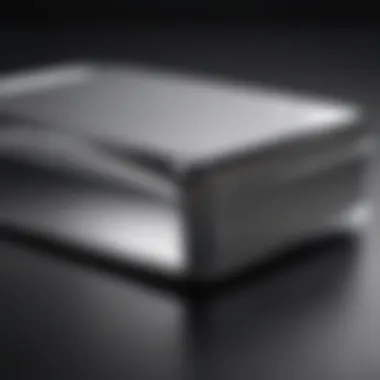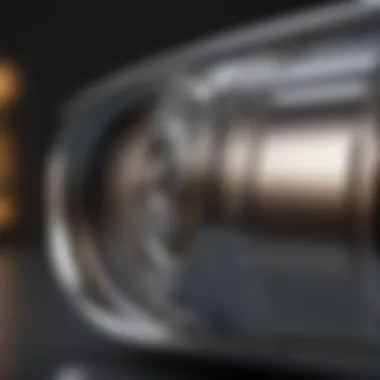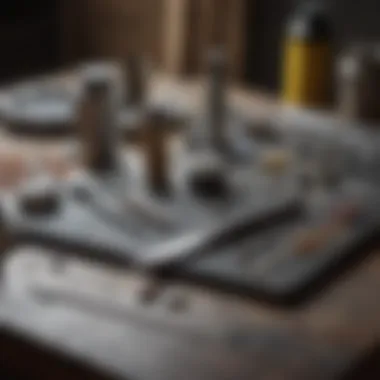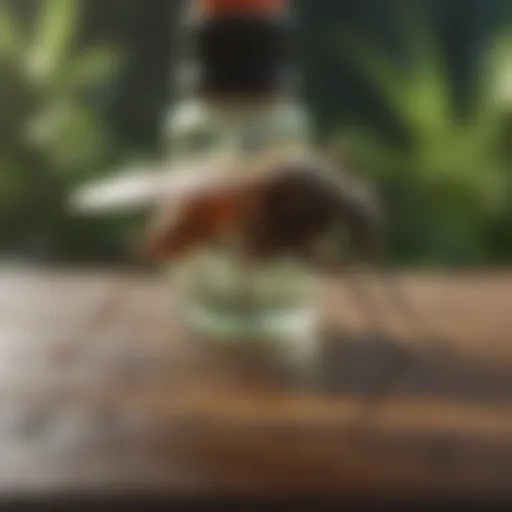Essential Guide to Choosing Chrome Polishes Effectively


Intro
Chrome polishing is an essential part of maintaining the appearance and integrity of chrome finishes used in various household items, from kitchen appliances to bathroom fixtures. This process not only ensures a shiny and attractive surface but also helps prevent corrosion and wear over time. Understanding the nuances of chrome polishes can empower homeowners to preserve their investments in aesthetics and functionality.
The importance of chrome polishing cannot be overstated. Regular maintenance contributes to a prolonged lifespan of chrome surfaces. Moreover, it enhances the overall aesthetic appeal of a home, providing a clean and well-kept impression. For those navigating the home improvement industry, acquiring knowledge about product selection and proper application techniques is crucial. This article will explore these aspects in detail, ensuring that readers have a solid foundation to make the best choices regarding chrome polishes.
The Basics of Chrome Polish
Understanding chrome polish is foundational for anyone aiming to maintain the aesthetic appeal and longevity of chrome finishes. Chrome plating is common in various items, from automotive parts to household fixtures. Its shine is not just for decoration; it also serves a protective role against corrosion and wear. However, over time, chrome surfaces can become dull, stained or oxidized.
Definition and Purpose
Chrome polish is a specialized product designed to clean, shine, and protect chrome finishes. The primary purpose of these polishes is to restore the original luster while providing a barrier against future damage. This restoration is important for both visual appeal and the durability of the chrome. In addition to aesthetic benefits, using the right polish can enhance the lifespan of the chrome surface, making it a worthwhile investment for homeowners and enthusiasts alike.
History of Chrome Finishing
The process of chrome finishing has a rich history that dates back to the early 20th century. Initially, chrome plating was developed as a way to enhance the durability and appearance of metal surfaces. Its popularity surged in the 1930s with the automotive revolution, as car manufacturers explored appealing aesthetics alongside functional durability. Over the decades, innovations in alloy formulation and polishing techniques emerged, making chrome finishes an industry standard in numerous applications. Today, the evolution of chrome finishing continues, with improved processes leading to better quality and longevity. Understanding this history provides context to the products available in the market today.
"Chrome polish acts as the protector for chrome finishes, extending their life and maintaining their shine."
By familiarizing yourself with the basics of chrome polish, you lay the groundwork for effective maintenance practices that preserve both functionality and beauty.
Types of Chrome Polish
Understanding the various types of chrome polish is essential for achieving and maintaining the best appearance for chrome surfaces. This section covers the most common forms of chrome polish available on the market. Knowing the differences between these types can assist you in choosing the right product for your specific needs and preferences. We will explore liquid and paste polishes, spray-on polishes, and wipes and cloths, discussing their particular characteristics, benefits, and considerations.
Liquid vs. Paste Polishes
Liquid and paste polishes are two popular forms of chrome polish. Each has unique attributes that cater to different preferences and circumstances.
Liquid Polishes often offer a more straightforward application process. They can be easily spread over surfaces with a cloth or sponge, making them handy for quick touch-ups. This form tends to penetrate intricate designs and details efficiently, ensuring thorough coverage. However, some liquid polishes may require more frequent application.
Paste Polishes, on the other hand, typically feature a thicker consistency. This allows them to adhere well to chrome surfaces, providing a more robust protective layer. The application might take slightly longer since users need to rub the paste into the surface. Nevertheless, the result can lead to a deep shine that lasts longer than their liquid counterparts.
When selecting between liquid and paste, consider your habits and the specific requirements of your chrome surfaces. If convenience is paramount, liquid may be better. If longevity and deep shine are more critical, paste is the way to go.
Spray-On Polishes
Spray-on polishes represent a different approach to chrome maintenance. Their convenience is one of their most significant advantages. With a simple spray application, you can cover expansive areas efficiently. This can be particularly effective for larger chrome surfaces like bumpers or entire car grills.
However, ease of use does not mean they are all equal. Some spray-on polishes provide excellent shine and protection, while others might fall short in effectiveness. It is vital to assess the product's ingredients and customer reviews before purchasing. Look for those containing high-quality protective compounds. This ensures that you receive both convenience and performance in a single package.
Wipes and Cloths
Wipes and cloths have become increasingly popular in recent years. They are essentially pre-soaked disposable sheets designed for quick clean-up and polishing. These products provide a straightforward solution for those who want to maintain their chrome surfaces with minimal effort.
The primary benefit of wipes is their convenience and portability. They can be kept in a car or household cleaning kit for quick access. Wipes may not deliver the same depth of shine as liquid or paste polishes, but they are effective for regular touch-ups and maintenance.


When choosing wipes, verify that they are specifically designed for chrome surfaces. This helps avoid potential damage or scratches that a wrong product could cause.
Using the proper type of chrome polish is crucial to maintaining the luster and integrity of chrome surfaces.
In summary, understanding the types of chrome polish available can make a significant difference in your upkeep routine. Each type - be it liquid, paste, spray-on, or wipes - has its advantages and disadvantages. Evaluating your specific needs and preferences will allow you to make an informed decision.
Evaluating Chrome Polish Quality
Evaluating the quality of chrome polish is vital to ensure that the products chosen meet the specific needs of your chrome finishes. A good quality chrome polish can significantly enhance the appearance of chrome surfaces while providing necessary protection against the elements. This section covers key aspects to consider when assessing the quality of these products, focusing on effectiveness, protective measures, and the durability of results.
Effectiveness in Removing Oxidation
One primary function of chrome polish is to remove oxidation. As chrome surfaces can tarnish and dull over time due to exposure to air and moisture, an effective polish must have the ability to restore their shine.
When selecting a polish, pay attention to the ingredients listed. Products containing abrasives typically provide better results in removing stubborn oxidation. However, be wary of overly abrasive formulas, as they can damage the chrome finish, leading to more significant issues down the line.
The application method also matters. A polish that requires minimal effort yet yields substantial results can save time and effort. Researching product reviews can help you gauge the general effectiveness of a particular polish in quickly dealing with oxidation. Products that are consistently praised for their performance in this regard should be prioritized in your decision-making process.
Protective Qualities
Once the chrome surface is polished, maintaining its shine is important. A high-quality chrome polish should offer protective qualities against future tarnishing and oxidation. Look for products that contain ingredients such as wax or sealants, which create a barrier against environmental elements. These features help prevent the chrome from being affected by water spots, dirt, and grime.
Additionally, protective polishes that are UV resistant are worth considering, particularly for items exposed to direct sunlight. Such options reduce the risk of fading or discoloration caused by prolonged sun exposure.
Remember: A product's packaging often highlights its protective qualities. Reading through these claims can aid in making informed choices.
Longevity of Results
It is not enough for a chrome polish to provide immediate shine; the longevity of those results is equally important. Buyers should assess how often a polish needs to be reapplied to maintain the desired look.
Some polishes promise long-lasting effects, while others may require more frequent applications. Generally, a good indication of longevity can be found in user experiences, often discussed in product reviews and forums. If users report maintaining a well-polished finish for an extended period without needing constant reapplications, that product is likely worth considering.
Finally, factors like environmental conditions and how often the chrome surface is used can affect the results as well. Be ready to adjust your choice based on your unique circumstances, as this will ensure the best outcomes for your chrome surfaces.
In summary, evaluating chrome polish quality involves examining its effectiveness against oxidation, the protective features it offers, and the longevity of the results it delivers.
Key Features to Look For
When selecting a chrome polish, it's crucial to consider certain key features that impact performance and usability. The right choice can enhance the appearance of your chrome surfaces while protecting them in the long run. Here are some fundamental elements to focus on:
- Safety for Chrome Finishes
- Ease of Application
- Availability of Ingredients
Safety for Chrome Finishes
Safety is paramount when choosing a chrome polish. Not all products are suitable for every surface. Some harsh chemicals can cause irreversible damage to chrome finishes. Opt for polishes specifically designed for chrome surfaces, as these products will prioritize their integrity. Manufacturers often include guidelines on their labels. Reading these can prevent costly mistakes and ensure your chrome remains pristine.
Ease of Application
The application process can greatly affect the overall experience with chrome polish. A product that is difficult to apply can lead to frustration. On the other hand, user-friendly polishes make the task straightforward. Look for options that come with clear instructions or an applicator built into the packaging.


For instance, polishes in spray form may offer easier, more even coverage, especially on larger surfaces. Meanwhile, paste-type products often require more effort but may provide more concentrated polishing effects. Consider what aligns best with your routine and giving you the best results in less time.
Availability of Ingredients
Finally, the availability of ingredients is another essential aspect to consider. Transparency regarding what goes into a polish can indicate its effectiveness and safety. Consumers should look for names of active ingredients listed clearly on the packaging. If you are conscious of environmental impact, also check whether the ingredients are eco-friendly.
Researching these components can help you avoid harmful substances. Additionally, if a product boasts natural ingredients, it may reduce the likelihood of adverse reactions. This can be especially important for households with children or pets.
In summary, focusing on safety, ease of application, and ingredient transparency can guide you in selecting an effective chrome polish. Your choice will impact not only the immediate results but also the long-term maintenance of your chrome fixtures.
Application Techniques
Effective application techniques are crucial in achieving optimal results when using chrome polishes. Proper preparation, execution, and finishing steps ensure not only the aesthetic appeal of the chrome but also its longevity. Understanding these techniques will help housewives and homeowners maintain their chrome surfaces in the best possible condition.
Preparing the Surface
Before applying any polish, the surface must be adequately prepared. This stage is vital as it sets the ground for the polishing process. Begin by cleaning the chrome surface to remove any dirt, grime, or previous residues. Use a gentle soap solution or a dedicated chrome cleaner with a soft cloth or sponge. Rinse thoroughly to avoid leaving any soap film which can hinder the polishing process.
Once cleaned, inspect the surface for any scratches or signs of oxidation. If needed, a mild abrasive can be used to gently buff out minor imperfections. Be cautious with abrasiveness to avoid damaging the chrome finish. Ensuring that the surface is completely dry is an essential final step, as moisture can interfere with the polish’s effectiveness.
Step-by-Step Polishing Process
The polishing process requires careful attention to detail to guarantee the best outcome. Here’s a step-by-step guide:
- Choose the Right Polish: Select a chrome polish suited to your needs. Read reviews and consider factors discussed earlier in the article.
- Apply the Polish: Squeeze a small amount of polish on a clean, soft cloth. It’s better to start with a little product and apply more if needed.
- Work in Sections: Divide the chrome surface into manageable sections. This will ensure you focus on one area at a time, allowing thorough and even application.
- Buff in a Circular Motion: Using moderate pressure, buff the polish onto the chrome in small circular motions. This method helps the product to adhere better and effectively remove oxidation.
- Wipe Off Residue: After allowing the polish to sit as directed on the label, use a clean part of the cloth to wipe off any excess polish. This step ensures that no residue remains.
- Repeat if Necessary: For particularly tarnished surfaces, repeat the process as needed until the desired shine is achieved.
This structured approach enhances effectiveness and can significantly improve the appearance of the chrome.
Finishing Touches
After polishing, the finishing touches can greatly impact the overall result. The final step in the process includes:
- Inspect the Surface: Examine the polished area for consistency in shine. Look for any remaining spots that might need reapplication of polish.
- Apply a Protective Coat: Some homeowners choose to apply a thin layer of wax after polishing. This provides additional protection against future tarnishing and gives a deeper shine.
- Buff Again: Lightly buff the surface with a clean microfiber cloth to enhance gloss.
- Regular Maintenance: Consider implementing a regular maintenance schedule. Periodic cleaning and polishing will help keep chrome looking new longer.
Proper application techniques can create a substantial difference in the appearance of chrome surfaces, providing both beauty and protection.
By understanding and implementing these application techniques, homeowners will find that maintaining their chrome finishes is not only achievable but also rewarding.
Maintaining Chrome Finishes
Maintaining chrome finishes is essential for preserving the sleek and polished appearance that chrome offers. Over time, chrome can lose its luster due to various factors such as exposure to the elements, chemicals, and physical wear. Regular maintenance not only enhances the aesthetic appeal but also increases the lifespan of chrome fixtures. Careful attention to routine cleaning and addressing specific issues can help keep chrome looking new for years.
Routine Care and Cleaning
Routine care is a fundamental aspect of maintaining chrome finishes. Regular cleaning helps to prevent the buildup of grime and tarnish, which can dull the surface. To effectively clean chrome:
- Use mild soapy water: Avoid abrasive cleaners that can scratch the surface. A gentle soap solution is often sufficient.
- Soft cloth or sponge: Use a microfiber cloth or a soft sponge to gently wipe the surface. This prevents scratching and removes dirt without harming the finish.
- Dry immediately: After cleaning, dry the chrome thoroughly with another soft cloth to prevent water spots.
Incorporating these practices into your regular cleaning routine not only ensures the chrome retains its shine but also prevents long-term damage, making maintenance easier in the future.


Avoiding Common Pitfalls
It is easy to make mistakes when caring for chrome finishes. Knowledge of common pitfalls can help in maintaining chrome effectively.
- Avoid harsh chemicals: Products containing bleach or ammonia can discolor and degrade chrome. Always opt for gentle cleaning solutions.
- Don’t use steel wool or abrasive pads: These tools can scratch the surface and lead to pitting. Stick with soft cloths and sponges for cleaning.
- Ignoring oxidation: Neglecting signs of oxidation can lead to irreversible damage. Regular inspection is vital.
Being aware of these pitfalls allows you to take proactive measures, ensuring the chrome remains unblemished and vibrant.
When to Reapply Polish
Knowing when to reapply chrome polish is another key aspect of maintenance. Reapplication should be prompted by a few factors:
- Loss of shine: If the chrome starts looking dull or lacks luster, it’s a clear sign that polish is needed.
- After cleaning: Following any routine cleaning, especially if using water, it’s prudent to reapply polish to restore the protective layer.
- Visible oxidation: If you notice any signs of oxidation, reapplying polish can help counteract further deterioration.
Regularly checking the condition of your chrome finishes and reapplying polish as necessary will keep surfaces protected from wear and looking their best.
Maintaining chrome finishes requires diligence and knowledge, but the reward is a lasting shine and protection against damage.
Efficient maintenance of chrome is not just about aesthetic appeal; it is about preserving the investment in your fixtures and ensuring they continue functioning well within your home.
Common Mistakes in Chrome Polishing
Polishing chrome can significantly enhance the appearance and longevity of the surface. However, many people make critical errors during the polishing process that can lead to subpar results or even damage. Recognizing common mistakes is essential. By avoiding these pitfalls, individuals can maximize the effectiveness of their polishing efforts and maintain their chrome finishes in optimal condition.
Using Inappropriate Products
One of the most significant errors in chrome polishing is the use of inappropriate products. Not all cleaning agents and polishes are suitable for chrome finishes. Many household cleaners contain harsh chemicals that can scratch or dull the surface. It is crucial to select specific chrome polishing products that are designed for this purpose.
Additionally, certain abrasive materials can cause irreversible damage. Products that are labeled for use on other surfaces, like stainless steel or aluminum, should not be used on chrome. Always read the labels and choose brands such as Mothers or Brasso which are known for their chrome-safe formulations. This choice ensures the surface remains intact while achieving a shiny finish.
Ignoring Manufacturer Guidelines
Ignoring manufacturer guidelines is another prevalent mistake. Each chrome polish comes with specific instructions regarding application, drying time, and removal. Failing to adhere to these recommendations can lead to less effective results. For instance, some polishes require a certain temperature range or may need to be applied in specific conditions to work effectively.
"Product efficiency often hinges on correct application. When in doubt, consult the manual."
By disregarding these guidelines, users may inadvertently harm the chrome or fail to achieve the desired shine. Always take time to read the guidelines thoroughly before embarking on the polishing process.
Over-Polishing Effect
Over-polishing is a frequently overlooked issue that can dramatically affect the quality of chrome surfaces. While polishing aims to restore shine, excessive polishing can thin the protective layer of chrome over time. This wear creates vulnerabilities that expose the metal underneath to rust and corrosion.
It is essential to polish in moderation. Focus on maintaining a regular cleaning routine rather than engaging in heavy polishing sessions. For many, once or twice a year is sufficient for maintenance. Sticking to this schedule helps preserve the chrome finish while still achieving that desired brilliance.
Ending
In summary, this article has explored the crucial aspects of chrome polishing, providing insightful guidelines for effective selection and application of chrome polish. Understanding the topic of keeping chrome surfaces pristine is important for both aesthetic appreciation and maintenance. By choosing the right polish and following correct applications, one can significantly enhance the longevity and appearance of chrome surfaces.
Summary of Key Points
- Types of Polishes: Various forms of chrome polish exist, including liquid, paste, and spray. Each has distinct advantages depending on the task at hand.
- Evaluating Quality: Important criteria include effectiveness in removing oxidation and the protective qualities of the polish.
- Application Techniques: Proper surface preparation and following a step-by-step process can yield optimal results, ensuring the chrome shines without damaging the finish.
- Common Mistakes: Avoid the use of inappropriate products, ignore proper guidelines, and refrain from over-polishing, which can harm the surface.
Final Thoughts on Product Selection
When it comes to selecting the right chrome polish, one should consider ingredients and safety for the intended surfaces. It is wise to look for products noted for their quality and effectiveness as highlighted in our discussions. It can be beneficial to read reviews from others who have used the products. Researching brands like Mothers Chrome Polish or Eagle One has proven invaluable for many users. By making informed decisions, housewives and homeowners can ensure their chrome surfaces not only look good but are maintained over time with minimal effort. Regular maintenance is a key aspect that cannot be overstated, as is being mindful of the common pitfalls in the application process.







